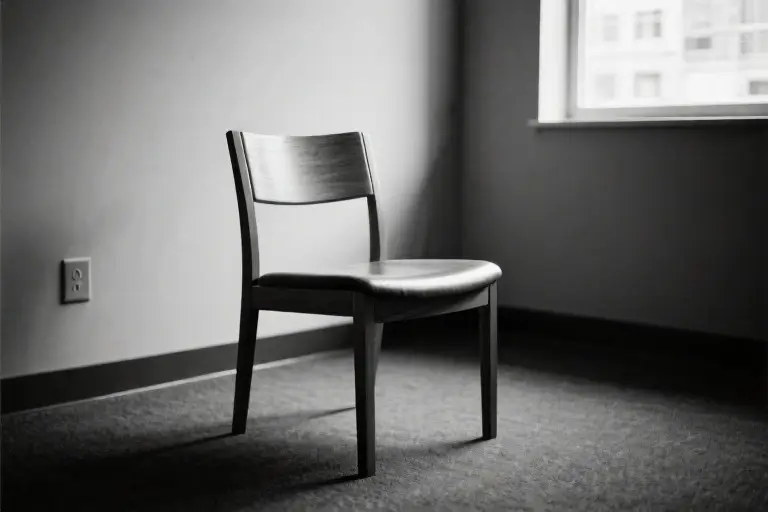I have been the lighthouse standing against the tide, unwavering, steady, guiding others home. For years, I’ve learned to weather every storm that came my way—not because I wanted to, but because someone had to. The cracks in my foundation were hidden beneath layers of \”I’m fine” and “Don\’t worry about me.” But the truth is, even the sturdiest structures crumble under constant pressure.
You might recognize this feeling if you\’ve ever been the one everyone leans on. The friend who always listens but never speaks their own pain. The colleague who absorbs the team’s stress without complaint. The family member who organizes, mediates, and holds everything together—until one day, you realize your hands are shaking from carrying what was never yours to hold alone.
Emotional burnout doesn’t announce itself with sirens. It creeps in through sleepless nights where your mind replays everyone’s problems but your own. It lingers in the hollow space between “How are you?” and the automatic “Good!” you parrot before anyone notices the hesitation. The strongest among us often break the quietest, our exhaustion mistaken for quiet resilience when it’s really the slow erosion of self.
They call us the strong ones—the emotional laborers who keep workplaces functioning, families intact, friendships alive. Society rewards this silent endurance with heavier crowns: “You’re so put-together,” they say, not realizing how desperately we wish someone would see through the performance. We become living paradoxes—both pillar and prisoner, both shelter and trapped within its walls.
Here’s what nobody tells you about being the lighthouse:
- The light you shine for others burns your own reserves
- Ships only notice you when they need direction, never when you’re weathering a hurricane alone
- Maintenance crews assume you’ll last forever without check-ins
When did we decide that strength means infinite capacity? That love requires self-erasure? That vulnerability disqualifies you from being someone’s safe space? The systemic neglect of emotional laborers isn’t just an oversight—it’s a cultural failing that equates human worth with productivity.
So I’ll ask what the waves never do as they crash against my weakening walls:
Who saves the lighthouse when the waters rise too high?
This isn’t rhetorical. I’m learning—and maybe you are too—that the answer starts with allowing our beams to dim sometimes. That true resilience includes knowing when to signal for help. That even guiding lights deserve caretakers.
When the Shelter Becomes a Cage: The Self-Objectification of Emotional Laborers
For five years, I was the unofficial therapist in my friend group—the human diary where everyone deposited their heartaches but never checked the storage limits. The breaking point came on a Tuesday evening when my phone buzzed with the seventeenth voice message that week. As another friend’s monologue about workplace drama played through my car speakers, I realized my hands were shaking too violently to grip the steering wheel. That’s when the dashboard blurred into a watercolor painting, and for the first time, I couldn’t distinguish between their tears and mine.
The Neuroscience of Over-Giving
Research from Stanford’s Center for Compassion and Altruism reveals a cruel irony: the same prefrontal cortex activity that makes us brilliant emotional supporters eventually sabotages our decision-making abilities. When we chronically prioritize others’ needs:
- Cognitive depletion occurs after just 30 minutes of sustained empathy (Journal of Neuroscience, 2021)
- Mirror neuron overload blurs the line between others’ pain and our own (Nature Human Behaviour)
- Emotional labor literally rewires neural pathways to prioritize external validation over self-preservation
Like a building retrofitted too many times, my brain’s architecture had become unstable—all those extra emotional load-bearing walls left no space for my own structural integrity.
“The Eldest Daughter Syndrome”: A Reader’s Confession
One submission from our community pierced particularly deep:
“At my father’s funeral, relatives praised how I held the family together. Nobody saw I’d practiced my ‘strong face’ in the bathroom mirror. When my little brother finally broke down, I remember feeling jealous of his freedom to crumble. That night, I washed his tear-stained shirt while mine stayed bone-dry—not because I wasn’t grieving, but because twenty-three years of being ‘the rock’ had dammed my tears permanently.”
Her story exposes the hidden toll of parentification trauma, where children learn to self-objectify into emotional service roles. The psychological ledger becomes horrifically skewed: we amortize our humanity to pay for others’ comfort.
Three Warning Signs You’re Treating Yourself as a Utility
- The Human Pause Button
Postponing your own needs becomes reflexive (“I’ll eat after I finish calming her down”) - Emotional Double-Bookkeeping
Keeping mental tally sheets of others’ crises while your own go unrecorded - The Martyrdom Metric
Secretly judging your worth by how much discomfort you can endure
Like lighthouse keepers who forget they too deserve solid ground, we mistake self-erasure for nobility. But here’s the tectonic truth: continents don’t apologize for occupying space, and neither should you.
The Invisible Weight: Why Society Punishes Strong People for Being Human
Sarah’s keyboard clicks echoed through the empty office at 11:37 PM as she filed the third project report this week. When she requested a mental health day after her anxiety diagnosis, the response stung: “We need our rockstar PM present—the team leans on you.” That same afternoon, an intern received full support for taking weeklong stress leave. This isn’t just workplace hypocrisy—it’s systemic emotional labor exploitation dressed in compliment wrappers (“You’re so resilient!”).
The Superhero Trap: How Cultural Narratives Betray Us
Marvel didn’t invent the “strong ones never break” mythos. From childhood, we’re handed archetypes like the self-sacrificing caregiver (“Be the mature one”), the tireless healer (“Doctors can’t get sick”), or the unshakable leader (“Never let them see you sweat”). These aren’t badges of honor—they’re emotional straitjackets with golden embroidery. Brené Brown’s research reveals the paradox: we admire vulnerability in theory but penalize it in practice, especially for perceived “pillars” of communities.
Three ways cultural scripts backfire:
- The Martyrdom Reward System – Praise for overwork (“Employee of the Month slept in the office!”) creates perverse incentives
- The Vulnerability Double Standard – Tears from a trauma survivor = brave; tears from their therapist = “unprofessional”
- The Infallibility Trap – One missed deadline erases 100 successes (“Wait, YOU make mistakes too?”)
Your Anonymous Confessional: When Did You Last Hide Your Struggle?
“I canceled my therapy appointment because my employee needed to vent about her breakup.” — Marketing Director, 34
“My parents still don’t know about my divorce. I’m their ‘stable child.'” — Nurse Practitioner, 41
“Promotion interview tomorrow. Practicing my ‘calm under pressure’ face instead of admitting I’m on anti-anxiety meds.” — Financial Analyst, 29
[Interactive Element]
Which ‘Strong Person’ Stereotype Exhausts You Most?
- ☐ The Mind Reader (“You always know what I need!”)
- ☐ The Human Band-Aid (“Fix this for me? You’re good at problems!”)
- ☐ The Emotional Shock Absorber (Your tears inconvenience others)
- ☐ The Infinite Battery (No recharge time needed)
Rewriting the Rules: Permission Slips for the Apparently Strong
- The 5% Disclosure Rule – Start small: “Actually, this week’s been tough for me too”
- Script Flipping – When praised for overwork: “I appreciate that, but sustainable pace matters more”
- The Strength Receipt – Keep a folder of “weakness wins” (e.g., asking for help led to better outcomes)
Neurologically, suppressing vulnerability activates the amygdala’s threat response. Essentially, pretending you’re invincible keeps your brain in fight-or-flight mode. The very “strength” we applaud may be eroding emotional resilience.
Tomorrow at work, notice who gets comfort for struggling versus who gets side-eye. That invisible hierarchy is what we’re dismantling—one honest “I’m not okay” at a time.
The Reconstruction of Vulnerability: A Four-Stage Recovery Guide
Stage 1: Recognizing the Signs of Emotional Overdraft
The first step in rebuilding after emotional exhaustion isn’t action—it’s awareness. Like a lighthouse keeper who notices the flickering light before the bulb burns out completely, we must learn to read our own distress signals. Emotional overdraft often manifests in ways we’ve been trained to ignore:
- Physical whispers: That persistent tension headache, the stomach that knots when your phone buzzes, the exhaustion that coffee can’t touch
- Emotional tells: Irritability over small things (“Why is everyone chewing so loudly?”), numbness during others’ crises, or inappropriate laughter when nothing’s funny
- Behavioral shifts: Canceling plans you once enjoyed, scrolling mindlessly for hours, or the opposite—filling every minute to avoid stillness
Try this self-audit: For one week, track these three metrics each evening:
- Energy deposits (activities/persons that replenished you)
- Energy withdrawals (situations that drained you)
- Unexpressed needs (thoughts you censored like “I wish I could cancel”)
The patterns will reveal your personal overdraft warnings. As one recovering caregiver noted: “Seeing how often I wrote ‘pretended to be fine’ in column three changed everything.”
Stage 2: Micro-Rejections: The Gym Workout for Boundaries
We don’t go from people-pleasing to empowered “no”s overnight. Like building muscle, boundary-setting requires progressive overload—starting with weights you can manage. These “micro-rejections” rewire your reflex to automatically say yes:
- The 10-minute pause: When asked for help, respond with “Let me check my schedule and get back to you in 10 minutes” (Use those minutes to check in with your gut, not your guilt)
- The partial yes: “I can’t take on the whole project, but I’ll review your draft for 20 minutes”
- The raincheck: “I want to give this the attention it deserves—can we talk tomorrow when I’m fresher?”
Remember: Early attempts may feel like betrayal. That’s not your conscience speaking—it’s your conditioning. One social worker reported: “My first successful ‘no’ made me vomit from anxiety. Now it feels like oxygen.”
Stage 3: Support Systems for the Supporters
Rebuilding requires scaffolding—people who hold space for your rebuilding. Seek these three types of allies:
- Peer supporters: Fellow “recovering caregivers” (Try searching “support groups for helpers” + your location)
- Professional guides: Therapists specializing in caregiver fatigue (Look for those trained in “compassion fatigue remediation”)
- Reverse mentors: Surprisingly, children often model healthy boundaries best (“My 5-year-old niece’s ‘I don’t want a hug right now’ taught me more than any book”)
Pro tip: Create a “support menu”—a literal list of what you need from different relationships (e.g., “With coworkers: debrief tough cases. With friends: no problem-solving, just movies.”) Share it proactively.
Stage 4: Rewriting Your Worth Equation
The deepest reconstruction happens when we dismantle the belief that our value equals our utility. Try these cognitive tools:
- The Being Resume: Alongside your achievements, list qualities unrelated to doing (“My laughter fills a room,” “I notice when flowers bloom”)
- Permission Slips: Write these daily and keep them visible (“Today I permit myself to… need help/be mediocre/not fix anything”)
- The 5-Minute Mirror: Each morning, meet your reflection and say aloud: “You are worthy of care because you exist, not because you excel”
As the lighthouse learns: Its purpose isn’t just to guide ships—it’s also to stand magnificent in its own right, whether or not any vessel needs its light tonight.
The Lighthouse Reimagined: Stories of Transformation
When Saying “No” Led to Unexpected Promotions
Sarah’s Story (ER Nurse, Chicago):
For 7 years, Sarah automatically accepted every overtime request—until collapsing during a night shift. “I realized I’d become the hospital’s emotional Band-Aid,” she shares. Her turning point? Declining extra shifts to complete trauma therapy training. Within months, her boundary-setting led to a surprise promotion: “My charge nurse said she finally saw me as leadership material when I demonstrated self-awareness.”
Psychologist’s Analysis:
“Sarah’s case exemplifies the vulnerability quotient in action,” notes Dr. Elena Torres. “Her refusal wasn’t rejection—it was evidence of emotional intelligence. Healthcare systems often mistake endurance for competence, when in fact, recognizing limits makes better caregivers.”
The Teacher Who Stopped Playing Superhero
Marcus’s Journey (High School Teacher, Toronto):
Known for staying late to counsel students, Marcus hit breaking point when he forgot his own anniversary. His radical change? Instituting “Office Hours” for student concerns instead of 24/7 availability. “The first time I said ‘Let’s discuss this tomorrow at 3pm,’ I expected backlash. Instead, students respected the structure.” His burnout symptoms decreased by 68% within 3 months (self-tracked via mood journal).
Expert Commentary:
“Marcus discovered what we call emotional labor redistribution,” explains educational psychologist Dr. Priya Nandi. “By creating systems instead of sacrificing himself, he actually increased his capacity to help—without depletion.”
From Family Pillar to Human Being
Lena’s Awakening (Oldest Daughter of Immigrants, London):
As her parents’ default translator since age 9, Lena only recognized her caregiver fatigue during a therapy exercise: “The prompt was ‘Describe yourself without roles.’ I sat there speechless.” Her watershed moment? Asking her siblings to split responsibilities equally. “I framed it as ‘I want to give Mom and Dad my best, not my leftovers.'” The family now uses a shared calendar for care tasks.
Psychological Insight:
“Lena’s breakthrough illustrates role disentanglement,” observes family therapist Dr. Jamal Wright. “Children who parentify themselves often fear relationships will collapse without their overfunctioning. In reality, boundaries create healthier interdependence.”
Your Turn: The “First No” Challenge
We invite you to share your boundary-setting milestone in our anonymous submission form. Whether it was:
- Rescheduling a friend’s vent session for your mental health day
- Turning down a “quick favor” that always becomes hours of unpaid labor
- Asking your partner to take over nighttime parenting duties
Why This Matters:
Every “no” to overextension is a “yes” to sustainable strength. As these stories show, setting emotional boundaries isn’t rejection—it’s an act of reconstruction.
“The lighthouse that knows when to dim its beam survives the hurricane.” — Shared by a reader in our support group
Resources Mentioned in This Chapter:
- Emotional Labor Calculator (Assess your caregiving balance)
- Scripts for Graceful Refusals (PDF download)
- Upcoming Workshop: “Redesigning Your Role” with Dr. Torres (Zoom link)
Tonight, I Permit Myself to Be Just a Nightlight
Standing sentinel has been my life’s work. The proud lighthouse – polished brass gleaming, beam cutting through the darkest storms. But tonight, I unclasp this weathered keeper’s cloak. The salt-crusted lenses can rest. The gears may sigh into stillness. I am learning that coastlines survive when beacons take turns.
We who’ve built careers on emotional labor know this truth in our marrow: caregiver fatigue doesn’t announce itself with sirens. It arrives as the third forgotten lunch, the mysteriously stiff shoulders during hugs, the way sunlight feels abrasive after decades of being everyone’s dawn. The cruelest paradox? Our culture rewards these silent erosions – pins “hero” medals on hollowed-out chests while whispering “but surely you can handle more?”
Here’s what we’re declaring instead:
The Shift Change Manifesto
- Rotating shifts: Emotional coastguards need relief crews. When one lighthouse dims, another’s beam takes over – not as failure, but as sustainable practice. Try this script: “I’m at 30% capacity today. Can we tag-team this conversation?”
- Maintenance hours: Bridges undergo inspections, why not caretakers? Block “vulnerability appointments” in your calendar like critical infrastructure.
- Demolition permits: Some shelters were built from obligation’s rotten timber. You’re licensed to dismantle them.
For those needing blueprints to begin:
Resources for the Weary Guardians
- Boundary phrasebook (sample excerpts):
- “I want to be fully present for this later. Can we pause until Tuesday?”
- “My emotional bandwidth is at low signal today.”
- Support networks:
- The Caregiver Space (online community with shift-scheduling tools)
- Emotional Labor Calculators (track invisible workload distribution)
- Emergency protocols:
- Text “SHOREBREAK” to 555-789 for immediate respite care referrals
- The Atlas of Interior Storms (guided journal for mapping personal erosion patterns)
Moonlight pools where lighthouse beams don’t reach. There’s profound safety in shadows – in admitting some waves needn’t be battled tonight. When we finally extinguish that compulsive glow, an astonishing truth emerges: the shore remains. The ships adapt. And in that tender darkness, we rediscover our own constellations.
The coast is clear. You may stand down.





